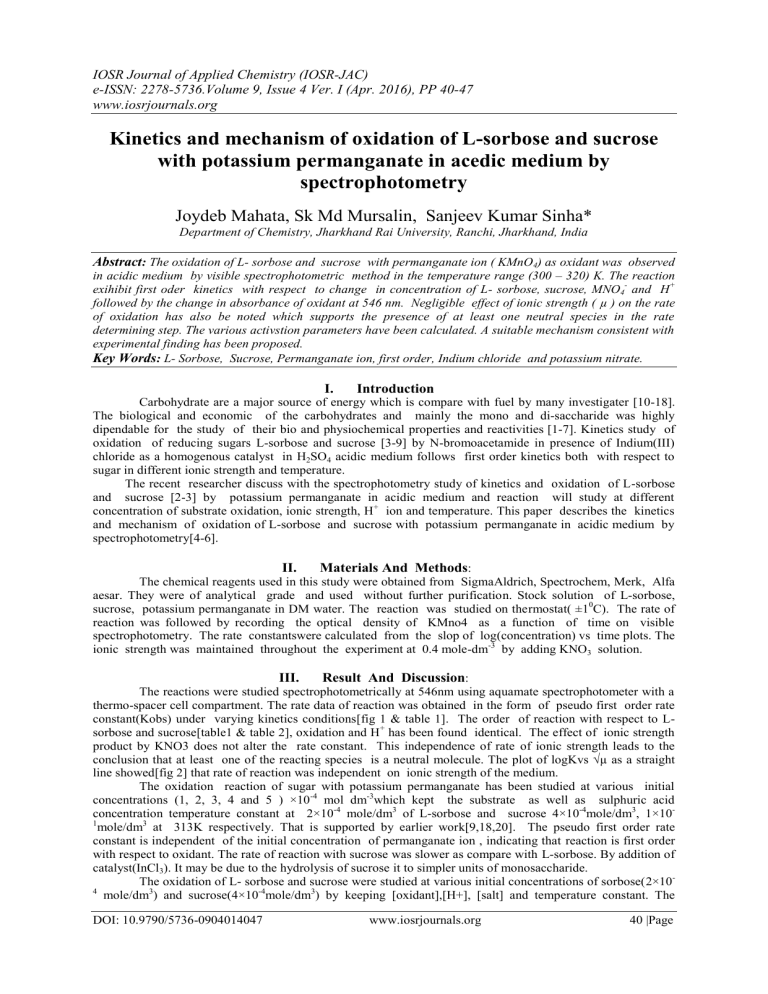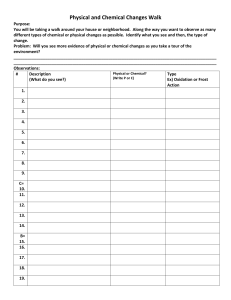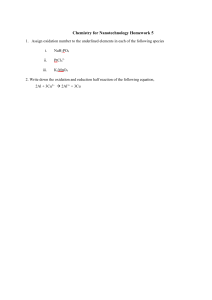
IOSR Journal of Applied Chemistry (IOSR-JAC) e-ISSN: 2278-5736.Volume 9, Issue 4 Ver. I (Apr. 2016), PP 40-47 www.iosrjournals.org Kinetics and mechanism of oxidation of L-sorbose and sucrose with potassium permanganate in acedic medium by spectrophotometry Joydeb Mahata, Sk Md Mursalin, Sanjeev Kumar Sinha* Department of Chemistry, Jharkhand Rai University, Ranchi, Jharkhand, India Abstract: The oxidation of L- sorbose and sucrose with permanganate ion ( KMnO4) as oxidant was observed in acidic medium by visible spectrophotometric method in the temperature range (300 – 320) K. The reaction exihibit first oder kinetics with respect to change in concentration of L- sorbose, sucrose, MNO4- and H+ followed by the change in absorbance of oxidant at 546 nm. Negligible effect of ionic strength ( µ ) on the rate of oxidation has also be noted which supports the presence of at least one neutral species in the rate determining step. The various activstion parameters have been calculated. A suitable mechanism consistent with experimental finding has been proposed. Key Words: L- Sorbose, Sucrose, Permanganate ion, first order, Indium chloride and potassium nitrate. I. Introduction Carbohydrate are a major source of energy which is compare with fuel by many investigater [10-18]. The biological and economic of the carbohydrates and mainly the mono and di-saccharide was highly dipendable for the study of their bio and physiochemical properties and reactivities [1-7]. Kinetics study of oxidation of reducing sugars L-sorbose and sucrose [3-9] by N-bromoacetamide in presence of Indium(III) chloride as a homogenous catalyst in H2SO4 acidic medium follows first order kinetics both with respect to sugar in different ionic strength and temperature. The recent researcher discuss with the spectrophotometry study of kinetics and oxidation of L-sorbose and sucrose [2-3] by potassium permanganate in acidic medium and reaction will study at different concentration of substrate oxidation, ionic strength, H + ion and temperature. This paper describes the kinetics and mechanism of oxidation of L-sorbose and sucrose with potassium permanganate in acidic medium by spectrophotometry[4-6]. II. Materials And Methods: The chemical reagents used in this study were obtained from SigmaAldrich, Spectrochem, Merk, Alfa aesar. They were of analytical grade and used without further purification. Stock solution of L-sorbose, sucrose, potassium permanganate in DM water. The reaction was studied on thermostat( ±10C). The rate of reaction was followed by recording the optical density of KMno4 as a function of time on visible spectrophotometry. The rate constantswere calculated from the slop of log(concentration) vs time plots. The ionic strength was maintained throughout the experiment at 0.4 mole-dm-3 by adding KNO3 solution. III. Result And Discussion: The reactions were studied spectrophotometrically at 546nm using aquamate spectrophotometer with a thermo-spacer cell compartment. The rate data of reaction was obtained in the form of pseudo first order rate constant(Kobs) under varying kinetics conditions[fig 1 & table 1]. The order of reaction with respect to Lsorbose and sucrose[table1 & table 2], oxidation and H+ has been found identical. The effect of ionic strength product by KNO3 does not alter the rate constant. This independence of rate of ionic strength leads to the conclusion that at least one of the reacting species is a neutral molecule. The plot of logKvs √µ as a straight line showed[fig 2] that rate of reaction was independent on ionic strength of the medium. The oxidation reaction of sugar with potassium permanganate has been studied at various initial concentrations (1, 2, 3, 4 and 5 ) ×10-4 mol dm-3which kept the substrate as well as sulphuric acid concentration temperature constant at 2×10-4 mole/dm3 of L-sorbose and sucrose 4×10-4mole/dm3, 1×101 mole/dm3 at 313K respectively. That is supported by earlier work[9,18,20]. The pseudo first order rate constant is independent of the initial concentration of permanganate ion , indicating that reaction is first order with respect to oxidant. The rate of reaction with sucrose was slower as compare with L-sorbose. By addition of catalyst(InCl3). It may be due to the hydrolysis of sucrose it to simpler units of monosaccharide. The oxidation of L- sorbose and sucrose were studied at various initial concentrations of sorbose(2×104 mole/dm3) and sucrose(4×10-4mole/dm3) by keeping [oxidant],[H+], [salt] and temperature constant. The DOI: 10.9790/5736-0904014047 www.iosrjournals.org 40 |Page Kinetics and mechanism of oxidation of L-sorbose and sucrose with potassium permanganate in values of pseudo first order rate constant was increased as the [substrate] increased[fig 1 & 3]. It was obserbed that the plot of 1/K vs 1/[con] has been found to be linear with positive intercept on Y axis and evidence of a complex formation between reducing sugars and permanganate ion (C6H12O6…..MnO4) [21-24][fig 4]. The following probable reaction may observed in the oxidation of L-sorbose and sucrose in acidic medium by permanganate ion. The reaction has been investigated on different hydrogen ion concentration varied by the addition of sulphuric acid at constant ionic strength(µ), oxidant and substrate concentration. The values of Kobs against [H+] are linear passing through the origin indicating that the order with respect to H + ion is unity[fig 5]. The rate increases with increase in [H+] indicating that only one proton is involved in the reaction. The rate of oxidation of sugar increases with increase in temperature and yielded the values of activation parameters(table-3). The value of activation parameters reflects that at least one of the reacting species in rate determining step involve a neutral molecule[fig 6]. The Arrehenius parameters were calculated as follows. The enthalpy of activation(ΔH*)was calculated from the activation energy using the equationat temperature of 313K The entropy of activation (ΔS*) in each reaction was evaluated in table 3 In presence of different concentratons (1.0 × 10-4 - 5.0 × 10-4 mol dm-3 ) of catalyst the reaction was enhanced by using 2.0 × 10-5 mol dm-3 KMnO4, 2.0 × 10-4 mol dm-3 L-sorbose, 4.0 × 10-4 mol dm-3 sucrose, 2.0 × 10-2 mol dm-3 H2SO4, 0.4 mol dm-3 KNO3. But pseudo first order rate constants were independent of its changing concentrations (table-4 , fig-4) IV. Reaction Mechanism: On the basis of the results the following mechanism is proposed for the above reaction. DOI: 10.9790/5736-0904014047 www.iosrjournals.org 41 |Page Kinetics and mechanism of oxidation of L-sorbose and sucrose with potassium permanganate in V. Conclusion When we used In(III) chloride as a homogeneous catalyst then the entropy of oxidation of L-sorbose and sucrose was show as -167 J/mol/K and -192 J/mol/K respectively. The negative value of entropy of activation observed the interaction between the species, leading to the formation of an activation complex [24]. DOI: 10.9790/5736-0904014047 www.iosrjournals.org 42 |Page Kinetics and mechanism of oxidation of L-sorbose and sucrose with potassium permanganate in Acknowledgements The authors are thankful to Dr.Sabita Sengar Vice chancellor J.R.U for providing necessary research facilities and also for her kind permission to publish the paper. References [1]. [2]. [3]. [4]. [5]. [6]. [7]. [8]. [9]. [10]. [11]. [12]. [13]. [14]. [15]. [16]. [17]. [18]. [19]. [20]. [21]. [22]. [23]. [24]. Singh AK, Chopra D, Rahmani S, singh B. “Kinetics and mechanism of Pb (II) catalysed oxidation of D-Arabinose, D-Xylose and D-Galactose by N-Bromosuccinimide in acidic solution”. Carbohydrates research .314: 1998, 151-160. Hanover, L.M and white J.S manufacturing composition, and application of fructose. Journal of clinical nutrition, 58, 1993, 724732. Singh AK, Srivastava J, Rahmani S. “Mechanistic studies of oxidation of D-Arabinose and D-mannose by Acidic solution of N Bromoacetamide in presence of chloro-complex of Ru (III) as Homogeneous catalyst” J. molec. Catal. A: Chemical. 271: 2007, 151- 160. Tripathi R, Upadhyay SK. “Kinetics of oxidation of reducing sugars by catalytic amount of Osmium (VIII) in the presence of periodate”. Int. J. Chem. Kinet. 36: 2004, 441-448. Dash S, Patel, S. and Mishra, B.K. oxidation by permanganet: synthetic and mechanesestic aspects.Tetrahedron, 65, 2009, 707739. Ruhoof J.R. n- heptanoic acid. Organic synthesis collection 2,1943, 315. Odebunmi, E.O, Twarere and owalude, S.O kinetics of oxidation of fructose . International journal of chemistry, 16, 2006, 167176. Srivastav. S and singh, S. kinetic study of Rh (III) catalysed oxidation of sucrose, Asian journal of chemistry, 20, 2008, 973-978. R. Naz. R. Azmat. R. Qamar and N. I. Siddiqi. Hg (II) catalysed oxidation of D-arabinose and D- mannose by Acidic solution of potassium permanganate: Kinetics and mechanism. Pak. J. chem. 4 (3): 2014, 116-123, Dash. S. and Patel. S. Mishra, Oxidation by permanganate: Synthetic and mechanistic aspects Tetrahedran, 65, 2009, 707-739. S. Karski and I. witonska,. Bismuth as an additive modifying the selective of palladium catalysts, J. mol. Catal, 191, 2003, 87. Pigman W, Horton D. „‟Stereochemistry of the Monosacharides” in The carbohydrates; Chemistry and Biochemistry, 2nd edition, Academic press, New York. (1):1972, 1- 67 Rafia Azmat, Rahella Naz Amna Khalil and Fahim Uddin. Kinetics and mechanism of oxidation of D-galactose and D- maltose with potassium permanganate in acidic medium by spectrophotometry. Asin journal of chemistry, vol. 20. 2008, 2. Ashok K. S, S. Shalini, S. Jaya, and S. Reena. Kinetic and mechanism of the Ir (III) catalysed oxidation of Xylose and Maltose by potassium Iodate in Aquous alkaline medium, carbohydrate Research. 348: 2007, 1078-1090. Gupta ML, Bhathacharya N. “The oxidation of D-glucose, Dgalactose, D- xylose, L. arabinose and lactose with Bromine”, Indian J. Chem. 1983, pp354 – 361. Ashok K. S, Chaurasia, R Shahla, S. Jaya, S. Bharat. Mechanism of Ruthenium (III) Catalysis of periodate oxidation of aldoses in aquous alkaline medium. J. Molecular catalysis. 95 (3-4): 2004, 135-141. Okoro HK, Odebunmi EO. "Kinetics and mechanism of oxidation of sugar and sugar alcohols by KMnO4", Int. J. Physical Sci. 4(9): 2009, 471-476. P. Singh, R. Singh, A. K Singh and E. B. Singh Kinetics and mechanism of oxidation of D-fructose and D-lactose by permanganate ion in acidic medium J. Indian chem.. Soc., 62,1985, 206. H. K Okoro and E. O Odebunmi. Kinetics and mechanism of oxidation of sugar and sugar alcohols by KMnO 4. International journal of physical science vol. 4 (9), 2009, 471-476. Rafia Azmat, Raheela Naz, Noshab, Qamar, Imran malik. Kinetics and mechanism of oxidation of D-fructose and D-lactose by per manganate ion in an acidic medium. Natural science vol. 7. 2012, 466-478. Puri BI, Sharma LR, Pathania MS. Principle of Physical Chemistry 41st edition. Vishal publishing coIndia. 2007, pp 925-986. Rafia A, Samreen A, Sitwat Q, Faryal VM, Fahim U. “Aerobic oxidation of D-glucose by methylene Green in alkaline aqueous solution by visible spectrophotometry”. J. Appl. Sci. 6(13): 2006, 2784- 2788. Rahmani J, Singh AK, Chaurasia N, Srivastava, Singh AK,. “Ruthenate ion catalysed oxidation of D–Galactose and D-Xylose by alkaline solution of sodium metaperoidate: A Kinetic Study” J. chem. Res, 2005, 304-310. Sen-Gupta KK, Gupta S, Mandal SK. Kinetics and mechanism of oxidation of D-glucopyranose-6-phosphase and D-ribofuranose5-phosphate by chromium in perchloric acid media, Carbohydrate Research. 139: 1985, 185-190. Figure and Table captions Fig1. The linear plot of ln(A0-A∞)/(At-A∞) vs time on rate of oxidation of L-sorbose and sucrose. Fig2. The linear plot for oxidation of L-sorbose and sucrose at different µ1/2 Fig3. The linear plot of effect of concentration of oxidant KMnO4 on rate of oxidation of L-sorbose and sucrose. Fig4. The linear plot of concentration of substrate(10 -4 mol dm-3 ) vs K (10-4 S-1) for effect of variation of substrate concentration. Fig5. The linear plot of 1/K vs 1/[conc.] for L-sorbose and sucrose. Fig6. The linear plot of logk vs 1/T(K-1) for L-sorbose and sucrose. Table1. Variation of rate constant (KS-1) with KMnO4, L-sorbose and H2SO4 concentration. Table2. Variation of rate constant (KS-1) with KMnO4, sucrose and H2SO4 concentration. Table3. values of activation parameters. Table4. Effect of catalyst in the oxidation of L-sorbose and sucrose. DOI: 10.9790/5736-0904014047 www.iosrjournals.org 43 |Page Kinetics and mechanism of oxidation of L-sorbose and sucrose with potassium permanganate in Table 1 Variation of rate constant (KS-1) with KMnO4, L-sorbose and H2SO4 concentration 10- 5[KmnO4] (mol/ dm3) 2 3 4 5 6 2 2 2 6 6 2 4 2 2 10-4 [L-Sorbose] (mol/ dm3) 3 3 3 2 3 4 5 6 4 6 3 3 3 3 10-2[H2SO4] (mol/ dm3) 2 3 4 5 6 2 2 2 2 2 4 2 6 2 10-4 K ( S-1) 1.85 1.86 1.77 1.83 1.40 1.45 1.42 1.20 1.40 1.50 1.60 1.70 1.40 1.30 [KNO3] (mol/ dm3) 0.4 0.4 0.4 0.4 0.4 0.4 0.4 0.4 0.4 0.3 0.5 0.4 0.4 0.4 Table 2 Variation of rate constant (KS-1) with KMnO4, sucrose and H2SO4 concentration 10- 5[KmnO4] (mol/ dm3) 2 3 4 5 6 2 2 2 4 6 2 2 2 2 10-4 [Sucrose] (mol/ dm3) 5 5 5 2 3 4 5 6 4 6 6 6 3 3 10-2[H2SO4] (mol/ dm3) 2 2 2 2 3 2 3 4 5 6 2 3 2 2 10-4 K ( S-1) 0.96 0.99 0.99 1.10 1.20 1.02 1.03 0.99 0.96 0.98 1.01 1.02 1.04 0.98 [KNO3] (mol/ dm3) 0.4 0.4 0.4 0.4 0.5 0.4 0.4 0.4 0.4 0.5 0.3 0.4 0.4 0.4 TABLE- 3 VALUES OF ACTIVATION PARAMETERS Temp. 313 K,[KNO3] = 0.4 mol dm-3, [ H+] = 0.2 mol dm-3. Substrate = 2.0 × 10-4mol dm-3 L- sorbose, and4.0 × 10-4 sucrose. substrate L- Sorbose sucrose √µ (mol dm-3) 0.4 0.4 Ea (KJ/mol) 51.20 23.45 ΔH* (KJ/mol) 28.14 10.29 ΔS* (J/mol) -167 -192 ΔG≠ (KJ/mol) 80.42 70.39 Table 4 Effect of catalyst in the oxidation of L-sorbose and sucrose [InCl3] × 10-4 mol-dm-3 1 2 3 4 5 DOI: 10.9790/5736-0904014047 K × 10-4 . S-1 sucrose 1.23 1.25 1.27 1.30 1.21 K × 10-4 . S-1 L- sorbose 1.65 1.62 1.66 1.68 1.63 www.iosrjournals.org 44 |Page Kinetics and mechanism of oxidation of L-sorbose and sucrose with potassium permanganate in Sucrose L-Sorbose 5 4 ln(A0-A?)/(At-A?) 3 2 1 0 0 100 200 300 400 Time(Sec) Fig 1 (sucrose) (L-sorbose) 0.0060 0.0055 0.0050 lnK 0.0045 0.0040 0.0035 0.0030 0.0025 0.0020 1.20 1.22 1.24 1.26 1.28 1.30 1.32 1.34 1.36 1.38 µ1/2 (mol/dm3) Fig 2 (L-sorbose) (sucrose) 7 6 B (ln(Ao-A )/At-A ) 5 4 3 2 1 0 0 50 100 150 200 (time in sec) Fig 3 DOI: 10.9790/5736-0904014047 www.iosrjournals.org 45 |Page Kinetics and mechanism of oxidation of L-sorbose and sucrose with potassium permanganate in sucrose L-sorbose 2000 1800 1600 1400 B (1/k (sec)) 1200 1000 800 600 400 200 0 0 20 40 60 80 100 120 140 160 180 3 A (1/[conc.] (dm /mol)) Fig 4 (L-sorbose) (sucrose) 0.030 0.028 0.026 0.024 0.022 0.018 -1 ) 0.020 Kobs (sec 0.016 0.014 0.012 0.010 0.008 0.006 0.004 0.002 0.000 0.0 0.1 0.2 0.3 0.4 0.5 [H+] (mol/L) Fig 5 DOI: 10.9790/5736-0904014047 www.iosrjournals.org 46 |Page Kinetics and mechanism of oxidation of L-sorbose and sucrose with potassium permanganate in L-sorbose sucrose -3.0 -2.5 logk (sec -1 ) -2.0 -1.5 -1.0 -0.5 0.0 0.000 0.005 0.010 0.015 0.020 -1 1/T (K ) Fig 6 DOI: 10.9790/5736-0904014047 www.iosrjournals.org 47 |Page





